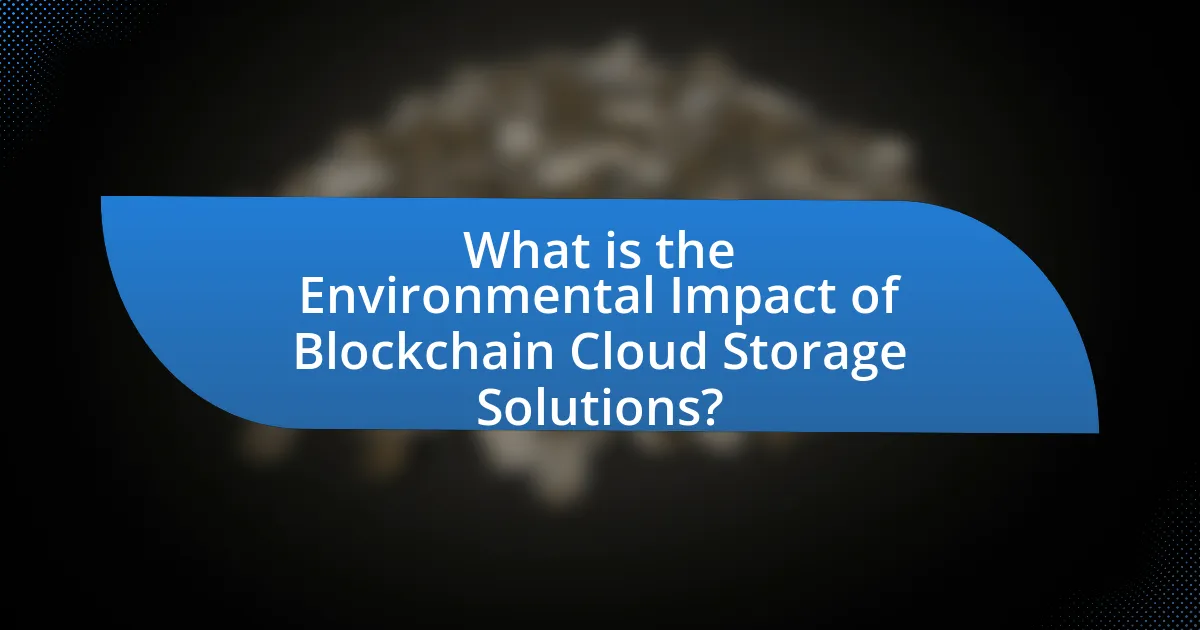The article examines the environmental impact of blockchain cloud storage solutions, highlighting their significant energy consumption and carbon footprint, particularly in proof-of-work systems. It details how blockchain technology decentralizes data storage, enhancing security but also increasing energy demands due to data redundancy. Key concerns include high energy usage, electronic waste, and reliance on fossil fuels, while potential benefits such as reduced carbon emissions and improved energy efficiency are also discussed. The article emphasizes the importance of adopting energy-efficient practices and technologies to mitigate the environmental effects associated with blockchain cloud storage.

What is the Environmental Impact of Blockchain Cloud Storage Solutions?
The environmental impact of blockchain cloud storage solutions is significant due to their high energy consumption and carbon footprint. Blockchain technology, particularly in proof-of-work systems, requires substantial computational power, leading to increased electricity usage. For instance, the Bitcoin network alone consumes approximately 100 terawatt-hours annually, comparable to the energy consumption of entire countries like the Netherlands. This energy demand often relies on fossil fuels, contributing to greenhouse gas emissions. Additionally, the decentralized nature of blockchain can lead to data redundancy, further exacerbating energy use. Therefore, while blockchain cloud storage offers benefits such as enhanced security and transparency, its environmental implications are considerable and warrant careful consideration.
How do blockchain cloud storage solutions function?
Blockchain cloud storage solutions function by decentralizing data storage across a network of nodes, utilizing blockchain technology to ensure data integrity and security. In this system, files are encrypted, fragmented, and distributed among multiple nodes, which prevents any single point of failure and enhances data security. Each transaction related to data storage is recorded on the blockchain, providing a transparent and immutable ledger that verifies ownership and access rights. This decentralized approach not only improves data resilience but also reduces reliance on traditional centralized data centers, which can have significant environmental impacts due to high energy consumption.
What technologies underpin blockchain cloud storage?
Blockchain cloud storage is primarily underpinned by distributed ledger technology (DLT), cryptographic algorithms, and peer-to-peer networking. Distributed ledger technology enables data to be stored across multiple nodes, ensuring redundancy and security. Cryptographic algorithms, such as SHA-256, secure data integrity and confidentiality, while peer-to-peer networking facilitates direct data sharing among users without intermediaries. These technologies collectively enhance the reliability and security of data storage solutions, making them resilient against data breaches and loss.
How does decentralization contribute to environmental effects?
Decentralization contributes to environmental effects by reducing the reliance on centralized data centers, which often consume significant energy and resources. By distributing data storage across multiple nodes, decentralization can lead to more efficient energy use, as local nodes may utilize renewable energy sources, thereby lowering carbon emissions. For instance, a study by the International Energy Agency indicates that data centers account for about 1% of global electricity demand, and decentralized systems can mitigate this impact by optimizing resource allocation and minimizing waste.
What are the key environmental concerns associated with blockchain cloud storage?
The key environmental concerns associated with blockchain cloud storage include high energy consumption, electronic waste, and carbon emissions. Blockchain technology, particularly in proof-of-work systems, requires significant computational power, leading to substantial energy usage; for instance, Bitcoin mining alone consumes more energy than some countries. Additionally, the hardware used for blockchain operations can contribute to electronic waste, as frequent upgrades and replacements are common in the tech industry. Finally, the reliance on fossil fuels for electricity generation in many regions exacerbates carbon emissions, further impacting climate change.
How does energy consumption compare to traditional cloud storage?
Energy consumption in blockchain cloud storage solutions is generally higher than in traditional cloud storage. Traditional cloud storage typically relies on centralized data centers that optimize energy efficiency through established practices, while blockchain systems require extensive computational power for consensus mechanisms, leading to increased energy usage. For instance, a study by the Cambridge Centre for Alternative Finance indicates that Bitcoin mining alone consumes more energy annually than some countries, highlighting the significant energy demands associated with blockchain technologies compared to conventional cloud storage systems.
What role does data redundancy play in environmental impact?
Data redundancy in blockchain cloud storage solutions significantly contributes to environmental impact by increasing energy consumption and resource utilization. The replication of data across multiple nodes ensures data availability and security but leads to higher electricity usage, as each node requires power for operation. For instance, a study by the International Energy Agency (IEA) indicated that data centers, which include blockchain storage, accounted for about 1% of global electricity demand in 2020, with redundancy practices exacerbating this figure. Consequently, while data redundancy enhances reliability, it also poses challenges for sustainability by amplifying the carbon footprint associated with energy-intensive operations.
What potential benefits do blockchain cloud storage solutions offer for the environment?
Blockchain cloud storage solutions can significantly reduce energy consumption and carbon emissions compared to traditional data storage methods. By decentralizing data storage, these solutions eliminate the need for large, energy-intensive data centers, which are responsible for a substantial portion of global electricity use. For instance, a study by the International Energy Agency indicates that data centers accounted for about 1% of global electricity demand in 2020. Additionally, blockchain technology can enhance data integrity and security, reducing the need for redundant data storage and thus minimizing the overall environmental footprint. This efficiency not only conserves resources but also promotes sustainable practices in the tech industry.
How can blockchain enhance energy efficiency in data storage?
Blockchain can enhance energy efficiency in data storage by enabling decentralized data management, which reduces the need for energy-intensive centralized servers. In traditional data storage systems, large data centers consume significant amounts of energy for both operation and cooling. Blockchain technology distributes data across a network of nodes, allowing for more efficient use of resources and minimizing redundancy. For instance, a study by the International Energy Agency indicates that decentralized systems can lower energy consumption by up to 30% compared to centralized counterparts. This reduction is achieved through optimized data retrieval processes and reduced infrastructure requirements, ultimately leading to a smaller carbon footprint for data storage solutions.
What are the implications for carbon footprint reduction?
The implications for carbon footprint reduction in the context of blockchain cloud storage solutions include significant decreases in energy consumption and greenhouse gas emissions. By utilizing decentralized storage systems, these solutions can optimize data management, leading to lower energy requirements compared to traditional centralized data centers. For instance, a study by the International Energy Agency indicates that blockchain technology can reduce energy consumption by up to 50% in certain applications due to its efficiency in processing transactions and data storage. This reduction directly contributes to a smaller carbon footprint, aligning with global sustainability goals.
How can the environmental impact of blockchain cloud storage be mitigated?
The environmental impact of blockchain cloud storage can be mitigated by implementing energy-efficient consensus mechanisms, such as Proof of Stake, which significantly reduce energy consumption compared to traditional Proof of Work systems. For instance, Ethereum’s transition to Proof of Stake has been reported to decrease energy usage by approximately 99.95%, demonstrating a substantial reduction in carbon footprint. Additionally, utilizing renewable energy sources for data centers can further lower emissions, as seen in initiatives by companies like Google and Microsoft, which aim for carbon neutrality. These strategies collectively contribute to a more sustainable blockchain cloud storage ecosystem.
What practices can be adopted to reduce energy usage?
To reduce energy usage, adopting energy-efficient technologies and practices is essential. Implementing energy-efficient hardware, such as servers with lower power consumption and optimizing data storage processes, can significantly decrease energy demands. For instance, transitioning to solid-state drives (SSDs) instead of traditional hard drives can reduce energy consumption by up to 80% due to their lower power requirements and faster data access speeds. Additionally, utilizing renewable energy sources, like solar or wind power, for powering data centers can further minimize the carbon footprint associated with energy usage. According to the International Energy Agency, data centers accounted for about 1% of global electricity demand in 2020, highlighting the importance of energy-efficient practices in this sector.
How can users choose eco-friendly blockchain storage options?
Users can choose eco-friendly blockchain storage options by selecting platforms that utilize energy-efficient consensus mechanisms, such as Proof of Stake, instead of energy-intensive methods like Proof of Work. For instance, blockchain networks like Cardano and Algorand operate on Proof of Stake, significantly reducing energy consumption compared to Bitcoin’s Proof of Work, which consumes approximately 99% more energy. Additionally, users should consider blockchain services that prioritize renewable energy sources for their data centers, as this further minimizes the carbon footprint associated with storage. Research indicates that transitioning to renewable energy can reduce blockchain’s environmental impact by up to 80%. By evaluating these factors, users can make informed decisions that align with eco-friendly practices in blockchain storage.
What future trends may influence the environmental impact of blockchain cloud storage?
Future trends that may influence the environmental impact of blockchain cloud storage include the adoption of energy-efficient consensus mechanisms, advancements in renewable energy integration, and the development of more efficient data storage protocols. Energy-efficient consensus mechanisms, such as proof-of-stake, significantly reduce energy consumption compared to traditional proof-of-work systems, which have been shown to consume vast amounts of electricity. For instance, Ethereum’s transition to proof-of-stake is projected to reduce its energy usage by approximately 99.95%. Additionally, the increasing use of renewable energy sources for powering data centers can further mitigate the carbon footprint associated with blockchain operations. Research indicates that data centers powered by renewable energy can reduce greenhouse gas emissions by up to 80%. Lastly, innovations in data storage protocols, such as sharding and off-chain solutions, can enhance efficiency and reduce the overall environmental impact of blockchain cloud storage by minimizing the amount of data that needs to be processed and stored on-chain.
How might advancements in technology improve sustainability?
Advancements in technology can improve sustainability by enabling more efficient resource management and reducing waste. For instance, blockchain technology enhances transparency in supply chains, allowing for better tracking of resource use and minimizing overproduction. According to a study by Accenture, implementing blockchain in supply chains can reduce waste by up to 20%, significantly lowering the environmental impact. Additionally, innovations in cloud storage solutions can optimize energy consumption, as decentralized systems can distribute data processing across multiple nodes, leading to lower carbon footprints compared to traditional centralized data centers.
What regulatory changes could affect blockchain cloud storage solutions?
Regulatory changes that could affect blockchain cloud storage solutions include data privacy laws, environmental regulations, and financial compliance requirements. Data privacy laws, such as the General Data Protection Regulation (GDPR) in Europe, impose strict guidelines on how personal data is stored and processed, which can impact the design and operation of blockchain storage systems. Environmental regulations may require blockchain solutions to adopt more energy-efficient practices, especially given the high energy consumption associated with many blockchain technologies. Additionally, financial compliance requirements, such as anti-money laundering (AML) and know your customer (KYC) regulations, could necessitate changes in how blockchain cloud storage providers manage user identities and transaction records. These regulatory frameworks are evolving, and their implications for blockchain cloud storage solutions are significant, as they can dictate operational practices and technological adaptations necessary for compliance.
What are best practices for minimizing the environmental impact of blockchain cloud storage solutions?
To minimize the environmental impact of blockchain cloud storage solutions, organizations should prioritize energy-efficient consensus mechanisms, such as Proof of Stake, over energy-intensive ones like Proof of Work. Implementing renewable energy sources for data centers significantly reduces carbon footprints; for instance, companies like Google and Microsoft have committed to using 100% renewable energy for their operations. Additionally, optimizing data storage through techniques like data deduplication and compression can lower energy consumption by reducing the amount of data processed and stored. Regularly auditing and upgrading hardware to more energy-efficient models also contributes to sustainability, as newer technologies often consume less power. These practices collectively enhance the environmental sustainability of blockchain cloud storage solutions.


